Chapter 15: Company accounts
Chapter learning objectives
Upon completion of this chapter you will be able to:
- explain the difference between a sole trader and a limited liability company
- illustrate the IAS1 required presentation of financial statements
- identify items requiring separate disclosure on the face of the income statement
- explain the capital structure of a limited liability company
- explain and illustrate the share premium account
- define a rights issue and its advantages and disadvantages
- record a rights issue in ledger accounts and show the effect in the statement of financial position
- define a bonus (capitalisation) issue and its advantages and disadvantages
- record a bonus issue in ledger accounts and show the effect in the statement of financial position
- explain and illustrate other reserves which may appear in a company statement of financial position
- explain why the heading, retained earnings, appears in a company statement of financial position
- explain how finance is raised by borrowing rather than by the issue of shares
- calculate and record finance costs in the ledger accounts and the financial accounts
- explain the requirements of IAS as regards current assets and liabilities
- explain the impact of tax on company profits and illustrate the ledger account required to record it
- record tax in the income statement and statement of financial position of a company
- explain and illustrate the recording of dividends.
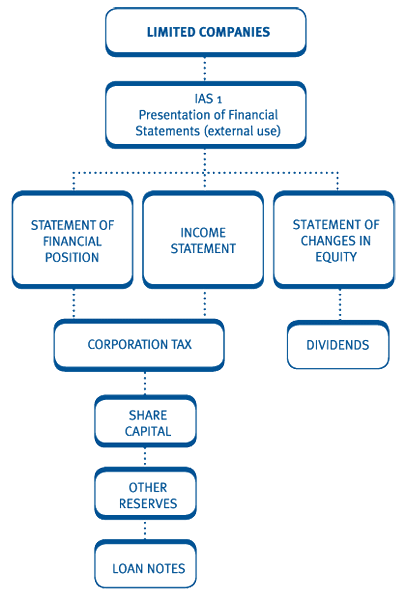
1 Characteristics of limited companies
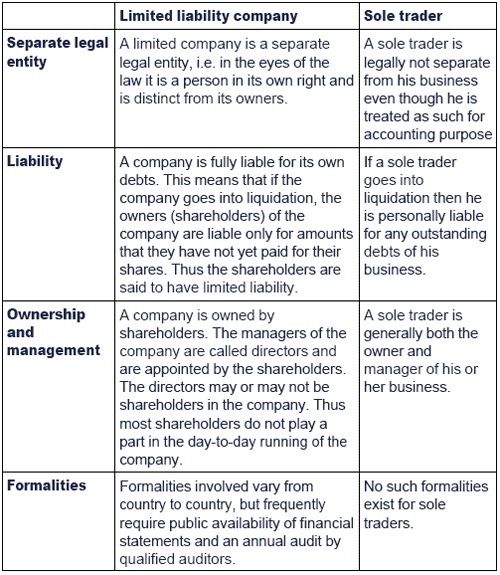

 Advantages of a limited company
Advantages of a limited company
The advantages of operation as a limited company rather than as a sole trader can be as follows:
- The liability of the shareholders is limited to the capital already introduced by them.
- There is a formal separation of the business from the owners of the business, which may be helpful to the running of the business. For example, if several members of a family are the shareholders in a company, but only two of the family are directors, it is clear to all concerned who is running the company.
- Ownership of the business can be shared between people more easily than in other forms of business organisation, e.g. a partnership.
- Shares in the business can be transferred relatively easily.
- There may be tax advantages.
The disadvantages of operation as a limited company rather than as a sole trader can be as follows:
- The costs of formation of the company.
- Costs of complying with companies’ legislation, including the audit requirement, if any.
- Directors of a company are subject to greater legislative duties than others running an unincorporated business.
- It is difficult/expensive to return capital surplus to the business’s requirements back to the shareholders.
- There may be tax disadvantages.

2 IAS 1 presentation of financial statements
IAS 1 incorporates the recommended formats for company published accounts. The following financial summaries are required:
- statement of financial position
- income statement
- statement of comprehensive income (only examinable where a revaluation of non-current assets has occurred)
- statement of changes in equity
- notes to the accounts
- a statement of cash flows and supporting notes
3 Statement of financial position
There are many similarities to the statement of financialposition of a sole trader, although some items will require furtherexplanation.
Note that IAS 1 requires an asset or liability to be classified as current if:
- it will be settled within 12 months of the statement of financial position date, or
- it is part of the enterprise’s normal operating cycle.
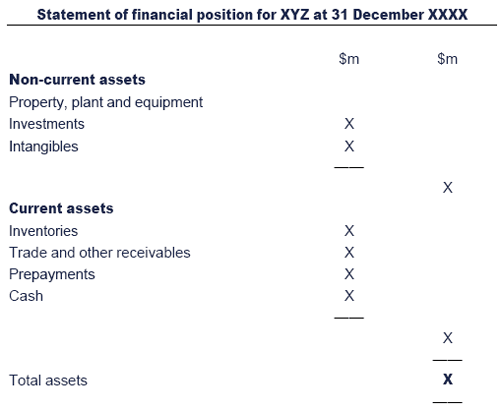
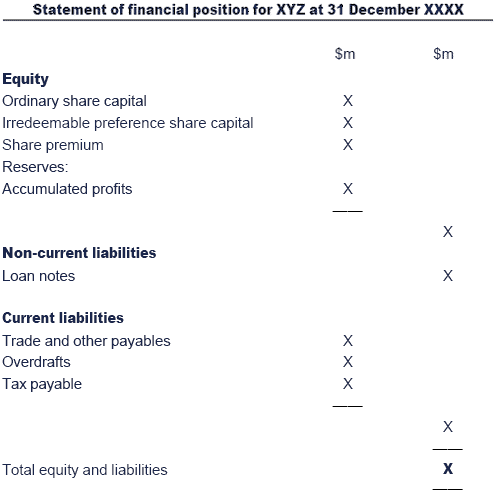

 Current assets and current liabilities
Current assets and current liabilities
The suggested statement of financial position format makes adistinction between current and non-current assets and liabilities. IAS 1sets down the rules to be applied in making this distinction.
Current assets
An asset should be classified as a current asset if it is:
- part of the enterprise’s operating cycle
- held primarily for trading purposes
- expected to be realised within 12 months of the statement of financial position date; or
- cash or a cash equivalent.
All other assets should be classified as non-current assets.
Note that this definition allows inventory or receivables toqualify as current assets under (a) above, even if they may not berealised into cash within twelve months.
Current liabilities
The rules for current liabilities are similar to those for current assets.
A liability should be classified as a current liability if:
- it is expected to be settled in the normal course of the enterprise’s operating cycle
- it is held primarily for the purpose of being traded
- it is due to be settled within 12 months of the statement of financial position date or
- the company does not have an unconditional right to defer settlement for at least 12 months after the statement of financial position date.
All other liabilities should be classified as non-current liabilities.

4 Income statement
Income statement
A recommended format for the Income statement is as follows:
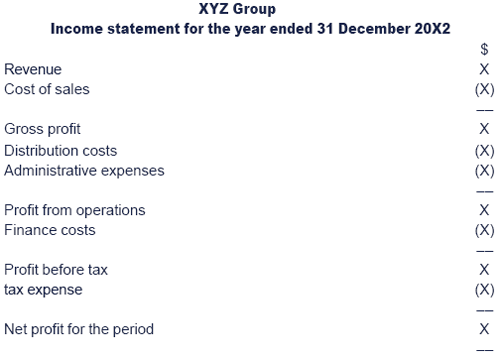
Disclosure notes
Notes are printed and published as part of the financialstatements. Their contents are normally specified by an accountingstandard.
Workings are confidential. They will not be published.

 Cost categories
Cost categories
Note that all expenses are classified under one of three headings:
- Cost of sales
This is calculated as for a sole trader. However the calculation should be shown in a note to the accounts rather than on the face of the income statement.
- Distribution costs
These are all expenses relating to selling or delivering products or services.
- Administrative expenses
This includes all expenses not classified within cost of sales or distribution costs.
Some expenses such as depreciation will be split across all three expense categories.

5 Statement of comprehensive income
The suggested format is as follows.

Exceptional items
There are certain circumstances where large one-off items requireseparate disclosure on the face of the Statement of comprehensiveincome, these are:
- restructuring or the reorganisation of the entity
- disposal of items of property, plant and equipment
- disposal of investment
- write downs of inventory or property, plant and equipment
These will be clearly shown in the question and should be shown on a separate line on the Statement of comprehensive income.
Relationship between the income statement and statement of financial position
The link between the statement of financial position and income statement is shown below:

 Income statement
Income statement
The income statement may be presented in one of two ways.
(1) The function of expenditure or cost of sales method shows expenses classified under the headings: cost of sales, distribution costs and administrative expenditure.
(2) The nature of expenditure method analyses expenses according to their nature:

Changes in inventories of finished goods and work in progress
This is simply the difference between the opening and closingamounts and could thus be a debit or a credit in the statement – ifinventories have risen it will be a credit and if they have fallen adebit. Note that raw materials inventories are included below ratherthan here.
Raw materials and consumables used
This is purchases of raw materials adjusted for opening and closing inventories.

6 Statement of changes in equity
This statement is included within the accounts to provide furtherinformation on certain statement of financial position accounts, namelyshare capital and reserves.
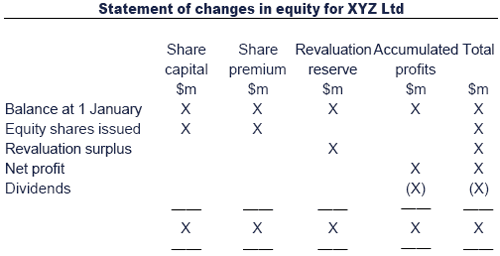
7 Share capital
A company is owned via shares.

- Redeemable preference shares are preference shares which are repayable by the company at a specified future date. On this date the shares are cancelled and the shareholders repaid.
These shares have the characteristics of debt. They are therefore classified as a liability on the statement of financial position.
- Irredeemable preference shares are preference shares which are not redeemable. They remain in existence indefinitely.
These shares are classified as equity on the statement of financial position.

 Share capital
Share capital
The share capital of a company may be divided into variousclasses. The company’s internal regulations define the respectiverights attached to the various shares, e.g. as regards dividendentitlement or voting at company meetings. In practice it is usuallyonly larger companies which have different classes of share capital.
Ordinary shares are the normal shares issued by a company. The ordinary shareholders are the real owners of the business
Ordinary shareholders may receive dividends from the company fromits profits. These dividends are often paid twice each year, an interimdividend during an accounting year and a final dividend after thestatement of financial position date when the company’s profit for theyear is known. Dividends will vary according to the company’s levelof profits and dividend policy. Ordinary dividends are often expressedin terms of cents (or dollars) per share. Sometimes in examinationquestions they are given as a percentage of the issued share capital.
No dividend may be paid on the ordinary shares until the preference share dividend has been paid in full.
Preference shares are shares carrying a fixed rate of dividend, theholders of which have a prior claim to any company profits availablefor distribution.
Special categories of preference shares include:
- Participating preference shares – where shareholders are entitled to participate together to a specified extent in distributable profits and surpluses on liquidation
- Redeemable preference shares – the terms of issue specify that they are repayable by the company.

Share capital values
- Each share has a nominal or par value, often $1, 50c or 25c. This value is often used as a means of calculating dividends to shareholders (paid as a percentage of the nominal value).
- Shares are issued by the company at an issue price. This is at least equal to the nominal value of the share, but often exceeds it.

 Market value of shares
Market value of shares
The market value of a share fluctuates according to the successand perceived expectations of a company. If a company is listed on thestock exchange, the value is determined by reference to recenttransactions between buyers and sellers of shares. This value does notfeature in the financial statements.

Share capital terminology
- Authorised share capital is the nominal value of the maximum number of shares that a company can have in issue at any particular point in time.
- Issued share capital is the share capital that has actually been issued to shareholders. The number of issued shares is used in the calculation of dividends.
- Called-up share capital is the amount of the nominal value paid by the shareholder plus any further amounts that they have agreed to pay in the future.
- Paid up share capital is the amount of the nominal value which has been paid at the current date.

 Accounting for the issue of shares
Accounting for the issue of shares
A company will generally issue shares at above par (nominal) value.
The double entry to record an ordinary or irredeemable preference share issue is:
Both the share capital and share premium accounts are shown on thestatement of financial position within the ‘Share Capital andReserves’ section.
The double entry to record a redeemable preference share issue is:

 Test your understanding 1
Test your understanding 1
Bourbon issues 200,000 25c shares at a price of $1.75 each.
Show this transaction using ledger accounts.

 8 Rights issues
8 Rights issues
A rights issue is:
the offer of new shares to existing shareholders in proportion totheir existing shareholding at a stated price (normally below marketvalues).
The advantages are:
- A rights issue is the cheapest way for a company to raise finance through the issuing of further shares.
- A rights issue to existing shareholders has a greater chance of success compared with a share issue to the public.
The disadvantages are:
- A rights issue is more expensive than issuing debt.
- It may not be successful in raising the finance required.
A rights issue is accounted for in the same way as a normal share issue.

 Test your understanding 2
Test your understanding 2
Upon incorporation in 20X4, The Jammy Dodger, a limited liabilitycompany, issues 1,000 50c shares at nominal value. Needing furtherfunds, in 20X5 it makes a rights issue of 1 for 5 at $0.75. This offeris fully taken up.
What accounting entries are required in 20X4 and 20X5? Illustratethe relevant section of the statement of financial position at year end20X5.

 9 Bonus issues
9 Bonus issues
A bonus (or capitalisation or scrip) issue is:
the issue of new shares to existing shareholders in proportion totheir existing shareholding. No cash is received from a bonus issue.
The advantages are:
- Issued share capital is divided into a larger number of shares, thus making the market value of each one less, and so more marketable.
- Issued share capital is brought more into line with assets employed in the company.
The disadvantages are:
- the admin costs of making the bonus issue.
As no cash is received from a bonus issue, the issue must be fundedfrom reserves. Any reserve can be used, though a non-distributablereserve such as the share premium account would be used in preference toreserves which can be distributed:

 Test your understanding 3
Test your understanding 3
Ginger Knut, a limited liability company, has 20,000 50c sharesin issue (each issued for $1.25) and makes a 1 for 4 bonus issue,capitalising the share premium account.
What are the balances on the share capital and share premium accounts after this transaction?
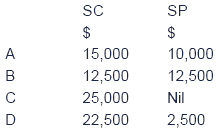


 Test your understanding 4
Test your understanding 4
Rich T is a limited liability company with 200,000 25c shares inissue. At 1 January the balance on the share premium account is $75,000.The following transactions occur in the year ended 31 December 20X6:
31 January There is a fully taken-up 2 for 5 rights issue. The issue price is $1.80.
12 August There is a 1 for 10 bonus issue made using the share premium account.
What are the balances on the share capital and share premium accounts on 31 December 20X6?
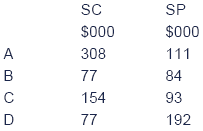

10 Other reserves
Any balances representing profits or surpluses owed to the shareholders are called reserves.

 Retained earnings
Retained earnings
Accumulated profits (retained earnings) appear in the capital andreserves section of the statement of financial position in the same waythat the profits of a sole trader are added to capital.
Retained profits are due (although generally not paid out) to theshareholders of the company. It follows that they should be presented aspart of the liability to the shareholders.

 11 Loan notes (loan stock)
11 Loan notes (loan stock)
- A limited company can raise funds by issuing loan notes.
- A loan note is a document that is evidence of a debt.
- A person will buy a loan note for a set nominal value, e.g. $100. He or she is effectively loaning $100 to the company.
- The nominal value of the loan note will be repayable after a certain number of years.
- In the meantime, the loan note-holder will receive an annual fixed amount of interest based on the nominal value.
- The interest incurred is included in ‘finance cost’ in the income statement.

 Test your understanding 5
Test your understanding 5
Custard Creameries is an incorporated business which needs toraise funds to purchase plant and machinery. On 1 March 20X5 it issues$150,000 10% loan notes, redeemable in 10 years’ time. Interest ispayable half yearly at the end of August and February.
What accounting entries are required in the year ended 31 December20X5? Show relevant extracts from the statement of financial position.

 12 Corporation tax
12 Corporation tax
- Companies are charged corporation tax on their profits.
- Accounting for tax is initially based on estimates, since a company’s tax bill is not finalised and paid until nine months after its year end.
- This means that a company will normally under– or over-provide for tax in any given year
- Tax will therefore appear in the year-end financial statements as:
- A charge to profits in the income statement being
- Current year estimated tax + previous year’s under-provision; or
- Current year estimated tax – previous year’s over-provision.
- A year end liability in the statement of financial position being the current year’s estimated tax.

 Test your understanding 6
Test your understanding 6
Garry Baldy commenced trade on 1 January 20X4 and estimates thatthe tax payable for the year ended 31 December 20X4 is $150,000.
In September 20X5, the accountant of Garry Baldy receives and pays atax demand for $163,000 for the year ended 31 December 20X4. At 31December 20X5 he estimates that the company owes $165,000 forcorporation tax in relation to the year ended 31 December 20X5.
Draw up the tax charge and income tax payable accounts for theyears ended 31 December 20X4 and 20X5 and detail the amounts shown inthe statement of financial position and income statement in both years.


 Test your understanding 7
Test your understanding 7
Choccychip estimated last year’s tax charge to be $230,000. Asit happened, their tax advisor settled with the tax authorities at$222,000.
This year, Choccychip estimate their tax bill to be $265,000, butthey are a little confused as to how this should be reflected in thefinancial statements. Which of the following is correct for the end ofthe current year?
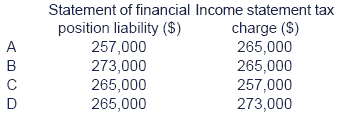

 13 Dividends
13 Dividends
- Dividends are the share of profits paid out to shareholders.
- Dividends on preference shares are a fixed amount.
- Dividends on ordinary shares are expressed as an amount per share e.g. 10c per share or 10% of nominal value
Preference dividends
In line with the statement of financial position presentation of preference shares:
- redeemable preference share dividends are classified as finance costs
- irredeemable preference share dividends are classified as dividends.

 Preference dividends
Preference dividends
The return is calculated as a percentage of the nominal value ofthe preference share capital. If, at the year-end, the company has notpaid all of the dividends due to preference share holders, the companywill show the amount owing as a current liability on the statement offinancial position under the heading ‘proposed dividends’ or‘interest accrual’.

Ordinary dividends
A company may pay a mid-year or interim dividend. The double entry is:

At the end of the year companies may propose or declare a dividendto the ordinary shareholders (i.e. tell the shareholders the amount of adividend to be paid after the year-end). This is a final dividend.These dividends have to be approved at the annual general meeting (AGM)and therefore cannot be a liability pre year-end and will not beexamined.

 Test your understanding 8
Test your understanding 8
Cracker, a company, has share capital as follows:
Ordinary share capital (50c shares) $200,000
8% Irredeemable Preference share capital $50,000
The company pays an interim dividend of 12.5c per share to itsordinary shareholders and pays the preference shareholders their fixeddividend. Before the year end the company declares a final dividend of36.5c per share to its ordinary shareholders.
Calculate the amounts shown in the statement of changes in equity(SOCIE) and statement of financial position (SFP) in relation todividends for the year.
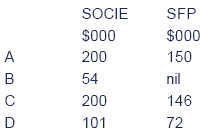

14 Preparation of company accounts
You will not be asked to produce a full set of accounts in theF3/FFA examination, although you may be required to provide certainbalances.
The following example will, however, help you to fully understand the preparation of company accounts.

 Test your understanding 9
Test your understanding 9
Preparation of company accounts
The trial balance of Penguin, a company as at 31 December 20X5 was as follows:

The following is to be taken into account.
(1) A building whose net book value is currently $5,000 is to be revalued to $11,000.
(2) A final ordinary dividend of 10c per share is to be proposed.
(3) The balance on the corporation taxaccount represents an overprovision of tax for the previous year. Taxfor the current year is estimated at $3,000.
(4) Closing inventory is $12,000.
(5) The balance on the suspense account represents the proceeds from the issue of 4,000 ordinary shares.
Prepare the following statements for the year ended 31 December 20X5:
(1) statement of comprehensive income
(2) statement of financial position
(3) statement of changes in equity
(4) an income statement (hence ignoring the revaluation)

Chapter summary
Test your understanding answers

 Test your understanding 1
Test your understanding 1



Working
Nominal value: 200,000 x 25 = $50,000
Funds raised: 200,000 x $1.75 = $350,000


 Test your understanding 2
Test your understanding 2

20X5 For every five shares a shareholder owns, he or she is areentitled to buy another one. The offer is fully taken up, meaning that200 new shares are issued.



 Test your understanding 3
Test your understanding 3
The correct answer is B
- For every four shares held, a new share is issued.
- Therefore 5,000 new shares are issued
Statement of financial position



 Test your understanding 4
Test your understanding 4
The correct answer is D

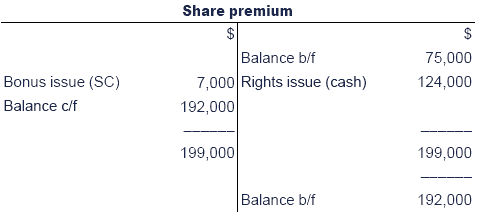

Workings
Rights issue: (200,000/5) x 2 = 80,000 new shares
Proceeds: 80,000 x $1.80 = $144,000
Nominal value: 80,000 x 25c =$20,000
Bonus issue: (280,000/10) x 1 = 28,000 new shares
Nominal value: 28,000 x 25c = $7,000


 Test your understanding 5
Test your understanding 5




 Test your understanding 6
Test your understanding 6

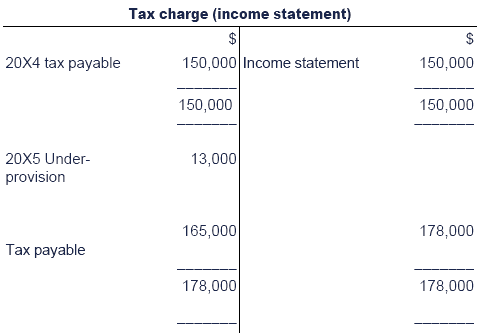
The income statement tax charge in 20X5 is increased to reflect the under-provision made in 20X4.



 Test your understanding 7
Test your understanding 7
The correct answer is B
- The liability in the statement of financial position = the estimated amount payable for the current year.
- The tax charge in the income statement = the estimated amount payable for the current year – last year’s overprovision.


 Test your understanding 8
Test your understanding 8
The correct answer is C
No. of ordinary shares = $200,000/50c = 400,000

Preference dividend
Statement of changes in equity

NOTE: The final dividend cannot be accounted for until approved at the AGM and therefore cannot be a liability pre year-end.


 Test your understanding 9
Test your understanding 9
Penguin
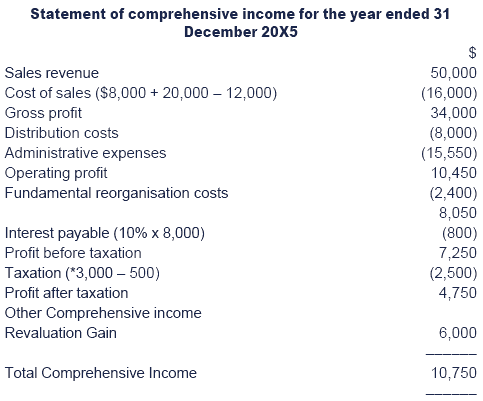

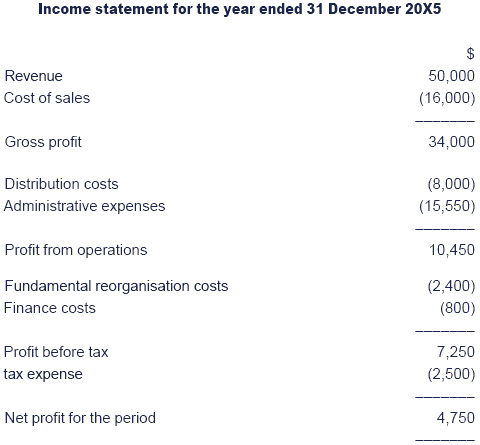
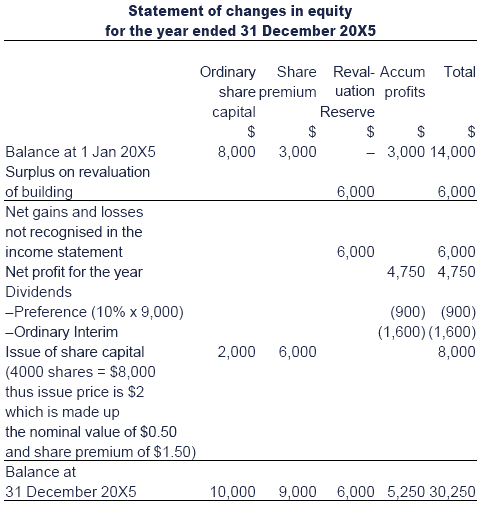

|
Created at 5/24/2012 3:37 PM by System Account
(GMT) Greenwich Mean Time : Dublin, Edinburgh, Lisbon, London
|
Last modified at 5/25/2012 12:53 PM by System Account
(GMT) Greenwich Mean Time : Dublin, Edinburgh, Lisbon, London
|
|
|
|
 |
Rating
:
|
 Ratings & Comments
(Click the stars to rate the page) Ratings & Comments
(Click the stars to rate the page)
|
 |
Tags:
|
|
|
|
|